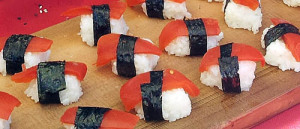Alastair Bland, a freelance writer based in San Francisco who covers food, agriculture and the environment, writes for NPR that San Francisco chef James Corwell wants to “create a great sushi experience without the tuna.”
 To make this Tomato Sushi, he skins and removes the seeds from fresh Roma tomatoes. Then he vacuum seals them in sturdy plastic bags and cooks them in hot water for about an hour — a technique called sous-vide.
To make this Tomato Sushi, he skins and removes the seeds from fresh Roma tomatoes. Then he vacuum seals them in sturdy plastic bags and cooks them in hot water for about an hour — a technique called sous-vide.
The process firms up the tomatoes and creates a texture similar to tuna. Corwell throws in a few more ingredients (he won’t divulge what they are), and slices them up. When eaten with sushi rice, nori, ginger, soy sauce and wasabi, they’re delicious.
Corwell is not the only entrepreneur experimenting with fish-like alternatives to seafood. (His product is so far available at one retail market in San Francisco and via mail order.) But with issues like overfishing, bycatch and high mercury levels gaining traction with consumers, it may only be a matter of time before demand kickstarts a faux-fish movement on the heels of the plant-based protein revolution already underway.
Corwell of Tomato Sushi was first convinced of the need to shift away from eating the bigger tuna species after visiting Tokyo’s celebrated Tsukiji fish market in 2007. He was stunned by the hundreds of frozen bluefin carcasses sprawled across the warehouse floor.
“The way I learned to cook with big slabs of meat [and fish] isn’t going to be possible in the future, and that’s nothing to be scared of,” Corwell says.
Tuna isn’t his only focus. Corwell has created an eggplant-based rendition of unagi and a granular seasoning blend meant to taste like dried, salted bonito flakes. Through the use of fermented ingredients and yeast, caramelization and lots of stovetop test runs, Corwell says he hopes to develop many more vegan sushi products.
“[Tomato Sushi] is the just the tip of the iceberg,” he says.
